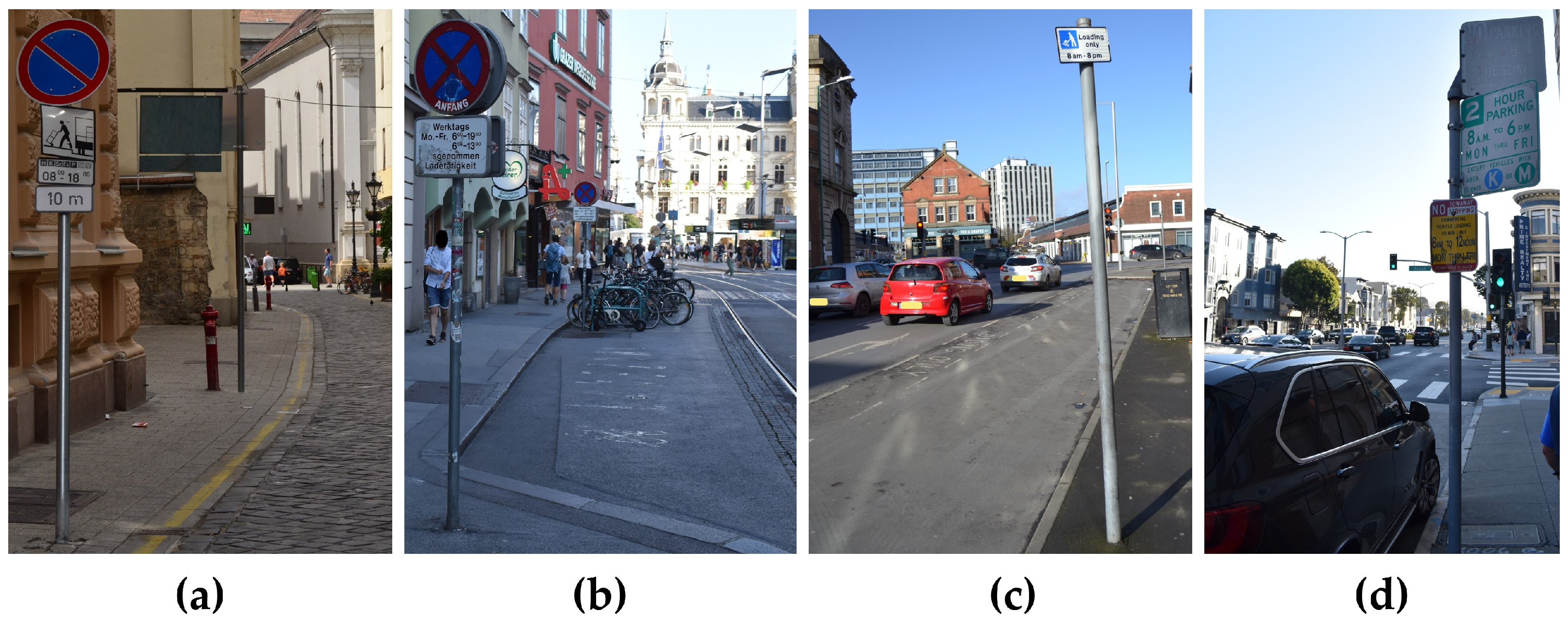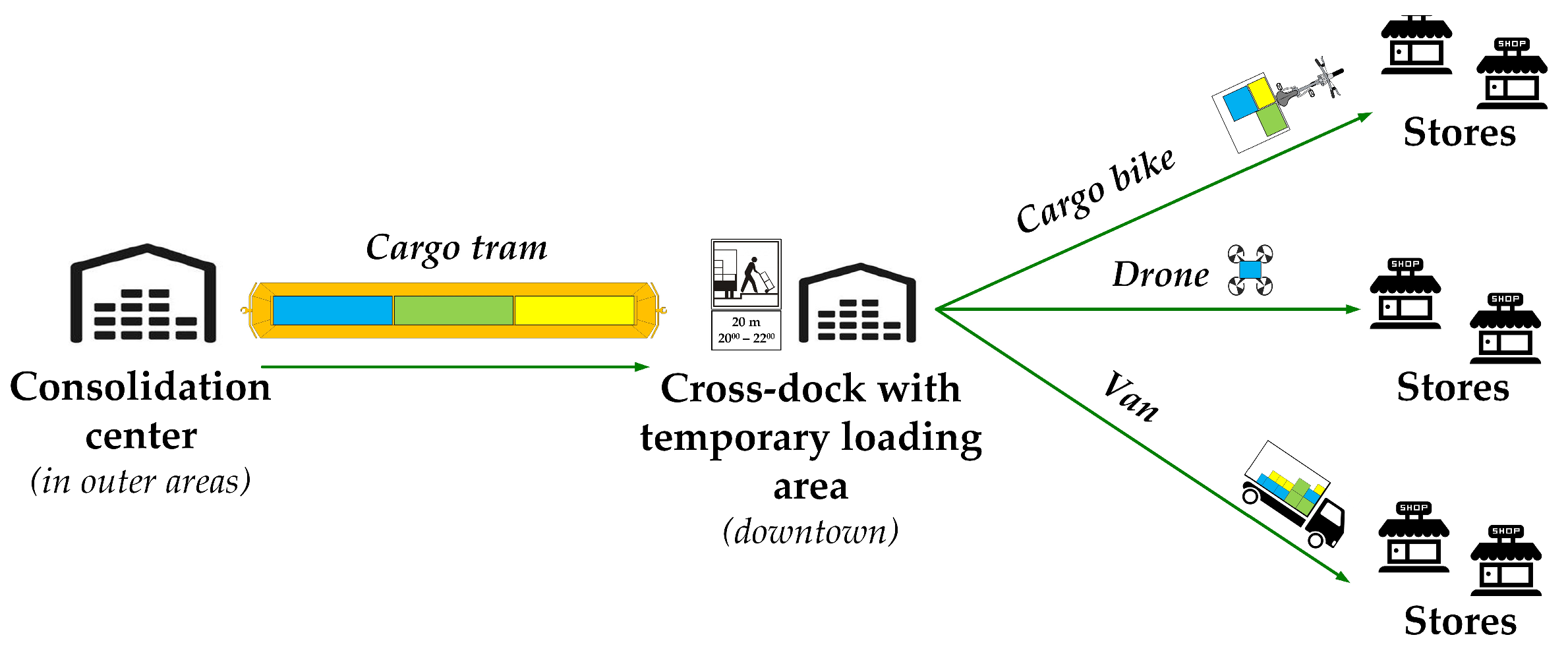The Future Role of Smart Devices in Systems of Urban Concentrated Loading Areas †
Abstract
1. Introduction
2. Literature Review: The Current Situation of Loading Areas
2.1. The Current Situation in Budapest
2.2. International Solutions
3. Applied Methods: Smart Devices in the System of Loading Areas
3.1. Main Functions and Relevant Smart Devices
3.2. Introduction Steps of Smart Loading Areas
3.3. Novel City Logistics Concepts with Loading Areas
4. Results and Discussion
5. Conclusions
Author Contributions
Funding
Institutional Review Board Statement
Informed Consent Statement
Data Availability Statement
Conflicts of Interest
References
- BME-ALRT. Website of the City Logistics Research Group. 2024. Available online: https://www.logisztika.bme.hu/citylog/en/ (accessed on 20 September 2024).
- Büki, A.; Kövér, I.B.; Sárdi, D.L. Developing a topological model for the city logistical analysis of urban shopping areas. In Proceedings of the BME Student Research Societies Conference, Budapest, Hungary, 14 November 2018. (In Hungarian). [Google Scholar]
- Reacty Digital. Új Szintre Léphet a Hazai e-Kereskedelem. 2020. Available online: https://enet.hu/uj-szintre-lephet-a-hazai-e-kereskedelem/ (accessed on 20 September 2024). (In Hungarian).
- Budapest Közút. Budapest Teherforgalmú Stratégiája. 2020. Available online: https://www.budapestkozut.hu/wp-content/uploads/2020/08/2016_Budapestkozut.pdf (accessed on 20 September 2024). (In Hungarian).
- BKK. Szegélyzóna. Tervezési útmutató—III. kötet; Strang, T., Ed.; 2024; Available online: https://bkk.hu/downloads/26848/ (accessed on 20 September 2024). (In Hungarian)
- HungAIRy. Actions Taken as Part of the HungAIRy LIFE Integrated Project. 2019. Available online: http://www.hungairy.hu/en/node/43 (accessed on 20 September 2024).
- Budapest Közút. Rakodótárcsák. 2024. Available online: https://www.budapestkozut.hu/teherforgalom/rakodotarcsak/ (accessed on 20 September 2024). (In Hungarian).
- MAHART Passnave. MAHART Hulladékszállító Hajó. Available online: https://mahartpassnave.hu/hu/bemutatkozas/hajopark-erdekessegek/mahart-hulladekszallito-hajo (accessed on 1 October 2024). (In Hungarian).
- Uglik, Z. Defining Metrics and Related Indicators to Evaluate the Spatial Properties of Parcel Locker Topologies Used in City Logistics. In Proceedings of the BME Student Research Societies Conference, Budapest, Hungary, 16 November 2023; Available online: https://tdk.bme.hu/conference/KJK/2023/sessions/LOG6/paper/Metrikak-es-kapcsolodo-indikatorok-definialasa (accessed on 20 September 2024). (In Hungarian).
- CIVITAS. Smart Choices for Cities: Making Urban Freight Logistics More Sustainable. 2020. Available online: https://civitas.eu/sites/default/files/civ_pol-an5_urban_web.pdf (accessed on 20 September 2024).
- Gonzalez-Feliu, J.; d’Arcier, B.F.; Salanova Grau, J.; Hervé, T.; Zubillaga, F.; Jeftic, Z.; Thebaud, J.; Aifandopoulou, G. The Deployment of Urban Logistics Solutions from Research, Development and Pilot Results. Lessons from the FREILOT Project. 2013. Available online: https://shs.hal.science/halshs-00784075/document (accessed on 1 October 2024).
- Hayes, S. MIRACLES Project GRD1—2001—40047, Deliverable D 4.2, Report on Evaluation Results, Annex 3—2nd Implementation Report for Barcelona. 2006. Available online: https://civitas.eu/resources/deliverable-d42-report-on-evaluation-results-annex-3-2nd-implementation-report-for (accessed on 20 September 2024).
- Areverda. Urban Goods Distribution (DUM). 2024. Available online: https://areaverda.cat/en/information/users/urban-goods-distribution (accessed on 1 October 2024).
- Leonardi, J.; Browne, M.; Allen, J.; Bohne, S.; Ruesch, M. Best Practice Factory for Freight Transport in Europe: Demonstrating How ‘Good’ Urban Freight Cases Are Improving Business Profit and Public Sectors Benefits. Procedia—Soc. Behav. Sci. 2014, 125, 84–98. [Google Scholar] [CrossRef]
- URBANE. Launch of URBANE’s Bologna Living Lab. 2024. Available online: https://www.urbane-horizoneurope.eu/news/launch-of-urbanes-bologna-living-lab/ (accessed on 20 September 2024).
- De Jesús Ochoa-Olán, J.; Betanzo-Quezada, E.; Romero-Navarrete, J.A. A modeling and micro-simulation approach to estimate the location, number and size of loading/unloading bays: A case study in the city of Querétaro, Mexico. Transp. Res. Interdiscip. Perspect. 2021, 10, 100400. [Google Scholar]
- Chiara, G.D.; Cheah, L. Data stories from urban loading bays. Eur. Transp. Res. Rev. 2017, 9, 50. [Google Scholar] [CrossRef]
- Dormehl, L. The Rise and Reign of Starship, the World’s First Robotic Delivery Provider. 2023. Available online: https://www.digitaltrends.com/cool-tech/how-starship-technologies-created-delivery-robots/ (accessed on 20 September 2024).
- Bellan, R. China’s WeRide Unveils Robovan, Its First Electric, Autonomous Cargo Van. 2021. Available online: https://techcrunch.com/2021/09/08/weride-jiangling-motors-and-zto-express-unveil-robovan-an-autonomous-cargo-van/ (accessed on 20 September 2024).
- Tadić, S.; Kovač, M.; Čokorilo, O. The Application of Drones in City Logistics Concepts. Promet—Traffic Transp. 2021, 33, 451–462. [Google Scholar] [CrossRef]
- Schwerdfeger, S.; Boysen, N. Optimizing the Changing Locations of Mobile Parcel Lockers in Last-Mile Distribution. Eur. J. Oper. Res. 2020, 285, 1077–1094. [Google Scholar] [CrossRef]
- Sárdi, D.L.; Domaniczki, V.; Bóna, K. Survey and Analysis of the Use of Signed Loading Areas in Hungarian Cities. In Logisztikai Évkönyv 2024; Hungarian Logistics Association: Budapest, Hungary, 2023; pp. 125–134. (In Hungarian) [Google Scholar]
- Tihanyi, J.; Ráduly, N.J. City Logistics Analysis of Loading Areas in Budapest. In Proceedings of the BME Student Research Societies Conference, Budapest, Hungary, 16 November 2023; Available online: https://tdk.bme.hu/conference/KJK/2023/sessions/LOG6/paper/Budapesti-rakodohelyek-city-logisztikai (accessed on 20 September 2024). (In Hungarian).
- Domaniczki, V. Smart Technologies in Urban Loading Management Processes. In Proceedings of the BME Student Research Societies Conference, Budapest, Hungary, 16 November 2021; Available online: https://tdk.bme.hu/conference/KJK/2021/sessions/LOG5/paper/Smart-technologiak-alkalmazasa-a-varosi (accessed on 20 September 2024). (In Hungarian).




Disclaimer/Publisher’s Note: The statements, opinions and data contained in all publications are solely those of the individual author(s) and contributor(s) and not of MDPI and/or the editor(s). MDPI and/or the editor(s) disclaim responsibility for any injury to people or property resulting from any ideas, methods, instructions or products referred to in the content. |
© 2024 by the authors. Licensee MDPI, Basel, Switzerland. This article is an open access article distributed under the terms and conditions of the Creative Commons Attribution (CC BY) license (https://creativecommons.org/licenses/by/4.0/).
Share and Cite
Bóna, K.; Sárdi, D.L.; Büki, A.; Domaniczki, V. The Future Role of Smart Devices in Systems of Urban Concentrated Loading Areas. Eng. Proc. 2024, 79, 15. https://doi.org/10.3390/engproc2024079015
Bóna K, Sárdi DL, Büki A, Domaniczki V. The Future Role of Smart Devices in Systems of Urban Concentrated Loading Areas. Engineering Proceedings. 2024; 79(1):15. https://doi.org/10.3390/engproc2024079015
Chicago/Turabian StyleBóna, Krisztián, Dávid Lajos Sárdi, Aletta Büki, and Viktória Domaniczki. 2024. "The Future Role of Smart Devices in Systems of Urban Concentrated Loading Areas" Engineering Proceedings 79, no. 1: 15. https://doi.org/10.3390/engproc2024079015
APA StyleBóna, K., Sárdi, D. L., Büki, A., & Domaniczki, V. (2024). The Future Role of Smart Devices in Systems of Urban Concentrated Loading Areas. Engineering Proceedings, 79(1), 15. https://doi.org/10.3390/engproc2024079015






